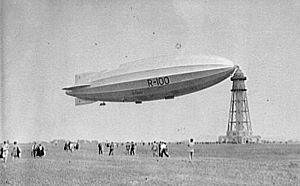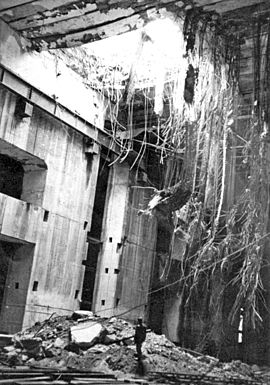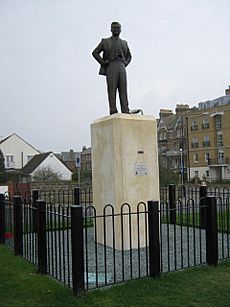Barnes Wallis facts for kids
Quick facts for kids
Barnes Wallis
|
|
|---|---|

|
|
| Born |
Barnes Neville Wallis
26 September 1887 Ripley, Derbyshire, England
|
| Died | 30 October 1979 (aged 92) Leatherhead, Surrey, England
|
| Resting place | St Lawrence's Church, Effingham, Surrey |
| Nationality | English |
| Occupation | Scientist, engineer and inventor |
| Known for | Inventing the bouncing bomb, geodesic airframe design and the earthquake bomb |
| Parent(s) |
|
| Awards | Albert Medal (1968) Royal Medal (1975) |
Sir Barnes Neville Wallis (born September 26, 1887 – died October 30, 1979) was a brilliant English engineer and inventor. He is most famous for creating the bouncing bomb. This special bomb was used by the Royal Air Force during World War II in a famous mission called Operation Chastise, also known as the "Dambusters" raid. The goal was to attack important dams in Germany's Ruhr Valley.
The exciting story of this raid was made into a movie in 1955 called The Dam Busters, where Barnes Wallis was played by actor Michael Redgrave. Besides the bouncing bomb, Wallis also invented a unique way to build aircraft frames called the geodetic airframe and powerful earthquake bombs.
Contents
Early Life and Education
Barnes Wallis was born in Ripley, Derbyshire, England. His parents were Charles William George Robinson Wallis and Edith Eyre Wallis. He went to school at Christ's Hospital in Horsham and Haberdashers' Aske's Hatcham Boys' Grammar School in London.
He left school at 17 to start working in January 1905 at Thames Engineering Works. Later, he moved his apprenticeship to J. Samuel White's, a company that built ships on the Isle of Wight. He first trained as a marine engineer, which means he designed and built things for ships. In 1922, he earned an engineering degree from the University of London External Programme.
Designing Aircraft
Wallis left J. Samuel White's in 1913 to become an aircraft designer. He first worked on large airships and then on aeroplanes. He joined a company called Vickers, which later became part of Vickers-Armstrongs. He worked there until he retired in 1971.
He helped design the Admiralty's first rigid airship, the HMA No. 9r. His first airship design, the R80, flew in 1920 and had many new ideas.
By 1930, when he designed the R100 airship, he had developed a new way of building called geodetic construction. This method used a criss-cross pattern, like a basket, which made the structure very strong and light. He also helped use light metals and new production methods for the R100's design.
Even though the R100 performed very well and flew successfully to Canada, it was taken apart after its "sister" ship, the R101, crashed. Later, the famous Hindenburg airship disaster led to airships no longer being used for mass travel.
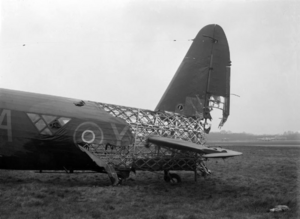
After the R101 crash, Wallis moved to the Vickers aircraft factory near Brooklands in Surrey. Before World War II, aircraft like the Wellesley, the Wellington, and later the Warwick and Windsor all used Wallis's geodetic design for their bodies and wings.
The Wellington bomber was known for having one of the strongest airframes ever built. There are impressive pictures of Wellingtons that were heavily damaged in battle but still managed to fly their crews home safely. The geodetic design made the aircraft light and strong. It also created clear spaces inside for fuel tanks and cargo.
Developing Bombs
When World War II started in 1939, Wallis believed that destroying the enemy's factories and power sources was key to winning the war. He wrote a paper suggesting huge bombs that could destroy very strong targets. His first super-large bomb design weighed about ten tons, which was much more than any existing bomber could carry. This led him to imagine a new plane, the "Victory Bomber," that could carry such a massive bomb.

In early 1942, Wallis started experimenting by skipping marbles over water in his garden. This led to his idea for the "Spherical Bomb – Surface Torpedo." The idea was that a bomb could skip over the water, avoid underwater nets, and then sink right next to a target like a battleship or a dam. When it exploded, the water around it would focus the blast onto the target.
A very important new idea was to make the bomb spin. Spinning the bomb made it trail behind the aircraft, which was safer for the plane. It also made the bomb travel further and prevented it from drifting away from the target as it sank. After some doubt, the Air Force accepted Wallis's bouncing bomb, code-named Upkeep. It was used to attack the Möhne, Eder, and Sorpe dams in Germany's Ruhr area.
The raid on these dams in May 1943, called Operation Chastise, became famous. The Möhne and Eder dams were successfully broken, damaging German factories and disrupting their hydro-electric power.
After the success of the bouncing bomb, Wallis went back to his idea of huge bombs. He created the Tallboy (6 tonnes) and then the Grand Slam (10 tonnes). These were "deep-penetration" or earthquake bombs. They were designed to hit the ground at very high speed and bury themselves deep before exploding, causing a small earthquake effect.
Even though no aircraft could carry these bombs to their ideal height, they could still be dropped from lower altitudes. They would hit the earth at supersonic speed and go down about 20 meters before exploding. These bombs were used against important German targets like V-2 rocket sites, strong submarine pens, bridges, and even the huge German battleship Tirpitz. They were the early versions of today's "bunker-busting bombs."
Post-War Research
After the war, Wallis returned to the Vickers factory at Brooklands. He became the Head of the Vickers-Armstrongs Research & Development Department. Here, he and his team worked on many futuristic aerospace projects, including supersonic flight and "swing-wing" technology. This technology allows an aircraft's wings to move backward and forward, which is useful for different speeds. It was later used in planes like the Panavia Tornado.
Wallis was very sad about the many airmen who died in the Dambusters raid. Because of this, he made sure that his future designs would not risk the lives of test pilots. He tested his designs extensively using models and became a leader in remote control for aircraft.
A huge Stratosphere Chamber, the world's largest of its kind, was built in 1948. Wallis led much research there in the 1950s and 1960s. This included work on supersonic aerodynamics that helped design the Concorde supersonic passenger jet. This special building was later restored at the Brooklands Museum.
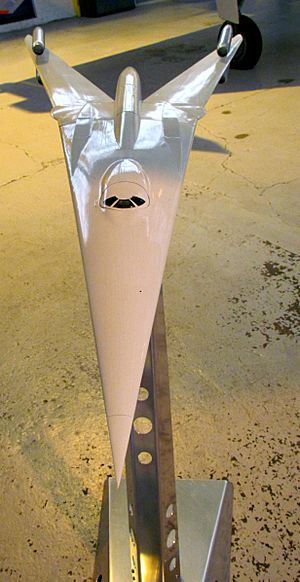
Wallis did a lot of engineering work to make the swing-wing idea practical. He also worked on the "Wild Goose" and "Swallow" aircraft designs, which were meant to be controlled entirely by wing movement. These were tested as large flying models. However, despite promising results, his designs were not chosen for production.
In the 1950s, Wallis developed an experimental rocket-powered torpedo called HEYDAY. It used compressed air and hydrogen peroxide and had a special shape to help it move smoothly through water. The only remaining example is at the Explosion! Museum of Naval Firepower in Gosport.
In 1955, Wallis became a consultant for the project to build the Parkes Radio Telescope in Australia. He suggested ideas like supporting the dish from its center and using a geodetic structure for the dish.
In the 1960s, Wallis also proposed using large cargo submarines to transport oil and goods underwater, avoiding bad weather. He believed they could travel faster and needed less power than regular ships. He also suggested new hull designs for deeper dives and using gas turbine engines in submarines. However, these submarine ideas were not developed.
Later in his life, he worked on ideas for an "all-speed" aircraft that could fly efficiently at all speeds, from slow to hypersonic (extremely fast).
Wallis became a Fellow of the Royal Society in 1945 and was made a knight in 1968. He also received an Honorary Doctorate from Heriot-Watt University in 1969.
Christ's Hospital School
Barnes Wallis received £10,000 for his important war work. He was so sad about the airmen who died in the Dambusters raid that he gave all of this money to his old school, Christ's Hospital. This donation helped set up the RAF Foundationers' Trust in 1951. This trust allowed children of RAF personnel who were killed or injured in action to attend the school.
When he retired from aircraft work in 1957, he became the Treasurer and Chairman of the Council of Almoners for Christ's Hospital. He held the Treasurer position for almost 13 years and oversaw a major rebuilding of the school.
Personal Life
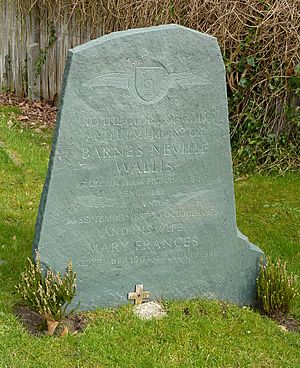
In April 1922, Wallis met his cousin-in-law, Molly Bloxam. He was 34 and she was 17. Her father did not want them to date, but he allowed Wallis to help Molly with her math by writing letters. They wrote about 250 letters, making them fun with fictional characters. The letters became more personal, and Wallis proposed marriage on Molly's 20th birthday. They married on April 23, 1925, and were together for 54 years until his death in 1979.
For 49 years, from 1930 until he died, Wallis lived with his family in Effingham, Surrey. He is buried there at St. Lawrence Church with his wife. His grave has a Latin saying: "Spernit Humum Fugiente Penna," which means Severed from the earth with fleeting wing.
They had four children: Barnes, Mary, Elisabeth, and Christopher. They also adopted Molly's sister's children, John and Robert McCormick, after their parents died in an air raid.
Wallis was a vegetarian and supported animal rights. He became a vegetarian at age 73.
In Film and Stories
In the 1955 film The Dam Busters, Barnes Wallis was played by actor Michael Redgrave. Wallis's daughter Elisabeth even played the camera technician in the water tank scene.
Wallis and his bouncing bomb invention are mentioned in the 1969 film Mosquito Squadron.
He also appears as a fictional character in Stephen Baxter's book The Time Ships. In this alternate story, World War I doesn't end in 1918, and Wallis focuses on inventing a time machine instead of the bouncing bomb.
His character and his World War II research lab are also featured in an episode of the British TV series Foyle's War (Series four, part 2).
Memorials
- Plaques and Sculptures
- There is a statue of Wallis in Herne Bay, Kent, close to Reculver where his bouncing bomb was tested. It was made by American sculptor Tom White in 2008.
- A special heritage plaque was put up at Wallis's birthplace in Ripley, Derbyshire, on May 31, 2009. It honors his work as a "Designer of airships, aeroplanes, the 'Bouncing Bomb' and swing-wing aircraft."
- A plaque from Lewisham Council is at 241 New Cross Road in New Cross, London, where Wallis lived from 1892 to 1909. He lived there from age five to 22. It is said that watching a ball skim across a wet football pitch nearby gave him the idea for his dam buster bomb.
- A memorial from Hillingdon Council is in Moor Lane, Harmondsworth. This is where the Road Research Laboratory tested models of dams to help Wallis develop the bouncing bomb.
- Sculpted busts (head and shoulders statues) of Wallis are at the Brooklands Museum and the RAF Club in London.
- Buildings
- The Student Union Building at the University of Manchester North Campus is named after Wallis.
- Nottingham Trent University also has a building named after Wallis on Goldsmith Street.
- A building at QinetiQ's site in Farnborough, Hampshire, is named in Wallis's honor.
- A public house (pub) named after Sir Barnes Wallis is in his hometown of Ripley, Derbyshire.
- Another pub called The Barnes Wallis used to exist near the railway station in Howden, East Riding of Yorkshire, where Wallis worked on airships.
- Street Names
- There is a Barnes Wallis Drive in Byfleet in Surrey, within the old Brooklands aerodrome area.
- There is also a Barnes Wallis Close in Effingham, Surrey, near where he lived.
- Other places with streets named after him include Chickerell, Weymouth (near where he tested the bouncing bomb), Bradford, Wiltshire, Apley in Telford, Segensworth in Hampshire, and Churchdown, Gloucestershire.
- Barnes Wallis Avenue is at Christ's Hospital school.
- A housing area in Buckshaw Village, Lancashire, is named Barnes Wallis Way.
- A housing area at the site of a former air base in Marske-by-the-Sea in North Yorkshire is also named after Wallis.
- Other Memorials
- The Yorkshire Air Museum at Elvington near York has a display about the Dambusters raid. It includes a copy of the bouncing bomb and the catapult used to test the idea by skimming stones.
- The Scafell Hotel in Rosthwaite, Keswick, has a Barnes Wallis Suite. This hotel was one of his favorite holiday spots.
- The RAF Manston History Museum in Kent has a section on Operation Chastise. It includes one of the few recovered practice 'Bouncing Bombs' that were tested nearby.
Archives
The Science Museum at Wroughton holds many of Barnes Wallis's papers. These include his design notes, photos, calculations, letters, and reports about his work on airships (like the R100), geodetic aircraft, the bouncing bomb, deep penetration bombs, and his "Wild Goose" and "Swallow" swing-wing aircraft.
Other papers by Barnes Wallis are kept at the Brooklands Museum, the Imperial War Museum in London, the Newark Air Museum, the Royal Air Force Museum in Hendon, Trinity College, Cambridge, and universities in Bristol, Leeds, and Oxford. The RAF Museum in Hendon also has a recreation of his post-war office at Brooklands.
See also
 In Spanish: Barnes Wallis para niños
In Spanish: Barnes Wallis para niños


